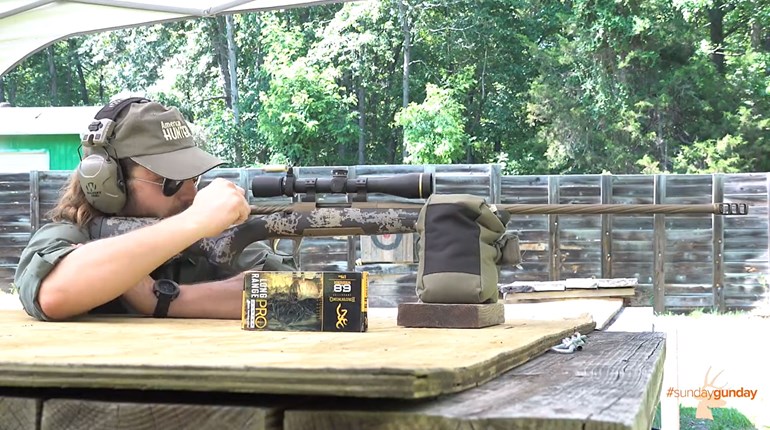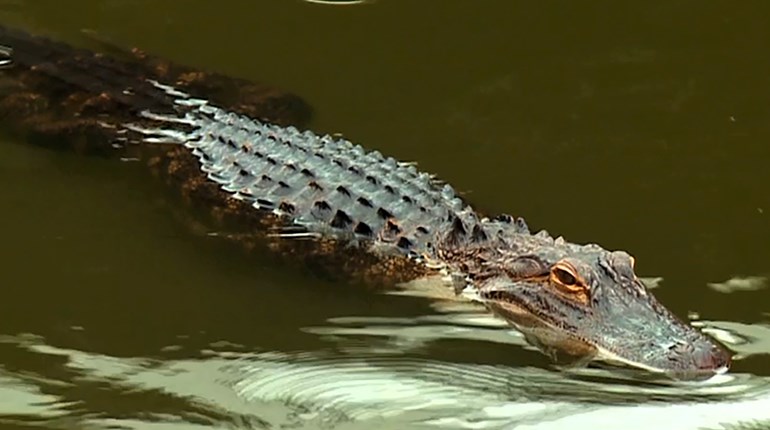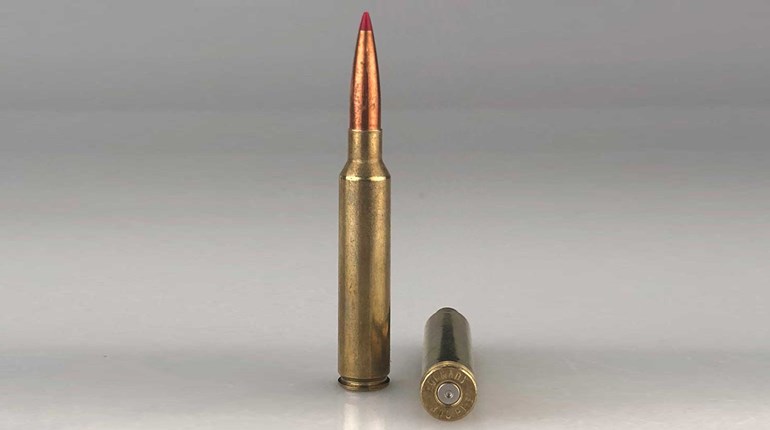Pete and I hear the crack of the ’06, and as we motor across the red Kalahari toward the sound we see Kabous and the springbok and Tom standing beside it with the Kimber by his side. It is the last game we will shoot here.
This week, Tom’s taken two springboks, a blesbok, a gemsbok and an ostrich. I’ve shot a dandy red hartebeest bull. But last week was the climax: I killed a Botswana bull elephant in the Caprivi Strip. Ron killed a croc and a hippo. Tom took a 23-inch red lechwe and a blue wildebeest.
The word “safari” certainly explains any voyage to or from the Strip. The 280-mile-long stretch of Namibia is sandwiched between Botswana, Angola and Zambia, and it holds the country’s only significant quantity of dangerous game. It took us two days to get there.
After getting worked over in transit like a sailor’s sea bag, after hunting “big” game at Kasika and after driving six hours to Kwando and hunting some more, the last thing I wanted to do was climb in another Toyota. But we tapped out in the Strip, so Kabous, Tom and I left Dwight to pursue his quest for a 70-pounder with Danie and Jamy and drove 12 hours across the country to hunt plains game here at Jamy’s farm, Panorama.
It’s easy to see why the place got its name. One can see for miles across its 15,000 acres of red-desert Kalahari south of Windhoek covered with camel thorn, black thorn and shepherd’s trees and teeming with kudu, gemsbok, zebra, blue wildebeest, impala, blesbok, springbok, duiker …
Jamy and his family live here. Guests stay in chalets—tents on concrete pads with queen beds, wardrobes and en suite baths. Everyone takes meals beneath a soaring thatched roof in the great room, open on two sides to reveal the surrounding countryside.
Tom, a first-timer in Africa, is proficient now with the ’06 and he doesn’t want to leave. I can see it in his shoulders. He wanted a trophy kudu bull most of all, but try as he might it didn’t happen. So he’s lingering the longest after two weeks away from home. Man, what a ride.
Big Game, Caprivi Style
Like campfires everywhere, ours tonight at Kwando Camp in the Strip inspires conversation, and I learn a lot about my hosts.
Besides me, there is Dwight Van Brunt, vice president of marketing at Kimber Manufacturing. He’s obsessive in the field—I know, because I’ve hunted elk with him—and his zeal drives us all. Ron Spomer is an AH field editor whose work you read in these pages. Tom Rickwalder is the development manager for NRA E-Media; he’s here to film our hunt. Dries Bronner is South African and a PH, but that’s not how he makes his living. He and his wife, Renette, love this stuff enough to burn vacation time, driving here from the Cape every year to help out Jamy as camp hosts. They bring their teenage son, Reinhardt, because he soaks up the outdoors, too. Karel “Kabous” Grunschloss is a 20-something man not long out of college, where he majored in tourism and recreation. The lure of the bush inspired him to become a PH. He signed on with Jamy Traut Hunting Safaris so he could apprentice for his big-game license. Danie Botha is big-game qualified, but he makes his living as a farmer. This week, Jamy was tied up with another safari and needed help so Danie agreed to pitch in for his friend. I like Danie. He’s big, affable and able.
Manufacturing. He’s obsessive in the field—I know, because I’ve hunted elk with him—and his zeal drives us all. Ron Spomer is an AH field editor whose work you read in these pages. Tom Rickwalder is the development manager for NRA E-Media; he’s here to film our hunt. Dries Bronner is South African and a PH, but that’s not how he makes his living. He and his wife, Renette, love this stuff enough to burn vacation time, driving here from the Cape every year to help out Jamy as camp hosts. They bring their teenage son, Reinhardt, because he soaks up the outdoors, too. Karel “Kabous” Grunschloss is a 20-something man not long out of college, where he majored in tourism and recreation. The lure of the bush inspired him to become a PH. He signed on with Jamy Traut Hunting Safaris so he could apprentice for his big-game license. Danie Botha is big-game qualified, but he makes his living as a farmer. This week, Jamy was tied up with another safari and needed help so Danie agreed to pitch in for his friend. I like Danie. He’s big, affable and able.
Curious, I ask Danie what is meant by “big-game qualified.” A PH license is one thing, he says. To guide hunters for big game one must apprentice for two seasons with a big-game guide and be in on three kills of at least two different species from the big five, croc and hippo then take a practical and written exam.
The night before I left the States my girlfriend and I saw Lyle Lovett and His Large Band in concert, and I realize a T-shirt they sold hit the spot. “Hell,” I say, “lechwe, wildebeest, reedbuck—that’s big game. What we hunted here in the Strip—elephant, hippo, croc—that’s not big, it’s large.
This morning was a prime example.
Kabous, Ron, Tom and I picked up a local game scout, Frank, and set off down the Kwandu River in search of lechwe and reedbuck. Right off the bat we struck naturalist gold: a colony of southern Carmine bee-eaters. We stared in wonder at what must’ve been a thousand of them. What a treat. But I left my 300mm lens in camp and took the .30-06 instead. I shot what I could with my short lens, and vowed never again to leave camp without my telephoto.
We saw lots of good red lechwes along shore, but they were in the Bwabwata Game Park,  off limits to hunting. So we motored downriver past sport fishermen, past tourists at a game lodge. Eventually, Frank directed us to a landing.
off limits to hunting. So we motored downriver past sport fishermen, past tourists at a game lodge. Eventually, Frank directed us to a landing.
It was quiet as we tied off the boat. Suddenly, we felt alone. Somebody called the place Lechwe Island. I think it was me when I thought about Capt. Benjamin Willard, Martin Sheen’s character in “Apocalypse Now,” when he said, “Never get off the boat.”We hadn’t gone a hundred yards when we spotted two hippos sleeping in the shade. They were facing away from us, snoozing, and the wind was in our favor, but the ’06 my hands suddenly felt dainty.
Soon after, we spied some lechwes but they weren’t trophies. Then I looked down and saw elephant dung. Kabous kicked it and I realized it wasn’t that old. Then we spotted them: a herd of cow elephants with calves feeding in the shade 200 yards away. At least the wind was in our favor.
Ten minutes later, our path back to the boat was blocked: the hippos had risen to return to the water. They say the most dangerous place to be is between a hippo and water. We weren’t, but we crouched only about 50 yards from them. Still, the wind was … I felt it on the back of my ears. This could be a problem. I figured if things got Western I’d run for a tree about 20 yards away and hide behind it.
Then I wished I had not my telephoto lens but the .458 Win. Mag. Kimber Caprivi loaded with Federal Premium Cape-Shok 500-grain Trophy Bonded Sledgehammer Solids I used on the Botswana bull. Yeah, forget the lens: I decided I’d never step off in dangerous-game country again without a big-bore.
Botswana Bulls
Kasika Camp, the base from where I shot my bull and Ron shot his hippo and croc, lies on a peninsula surrounded by backwater of the Chobe River. Every inch of earth here is verdant. Across the Chobe is Botswana and Chobe National Park. The Chobe turns into the Zambezi, and a long boat ride down that lies Vic Falls. Fish eagles and crocodiles ply the water.
On our side, below where we put in with the Asila, lies the Zambezi Queen, a giant houseboat. It’s not the only hospitality around here. Upriver on the Botswana side there are a couple of five-star lodges. Tourists are drawn to the wildlife in the park (mostly the elephants) and the fishing. Soon, fishing may be the only draw. Botswana recently shut down hunting. Deforestation caused by elephants is evident for as far as the eye can see. Mature adults forage for about 400 pounds of food a day, and will walk as far as 25 miles a day for the 50 gallons of water they need. Now that everything close to the river in Botswana is eaten, they must walk farther inland to find more food. How long before they outstretch their 25-mile range? If those Botswana elephants swim the Chobe in search of food, Namibia will have to think about increasing its quotas. Either that or the Botswana elephants will die of starvation.
The African elephant is Earth’s largest mammal. Unlike some species, it never stops growing. The largest of this largest species on land lives in western Zimbabwe, in the Hwange Park corridor; the animals in this population trade northwest and southeast, flowing through Botswana, Angola and Namibia. A bull of this ilk can be taller than 13 feet at the shoulder and weigh as much as 7 tons. To the east in the Zambezi Valley and on into Mozambique, the elephants are perhaps 20 percent smaller. In southern Tanzania’s Selous Reserve they are even smaller. In northern Tanzania and farther up into East Africa they grow larger again. And in the forests they are smallest yet; a mature forest bull rarely grows taller than 8 feet.
However, the largest bulls don’t necessarily grow the largest tusks, probably due to food, minerals and genetics. A Botswana bull can grow tusks 22 inches in circumference; the “small” bulls of the Selous produce at least as many hundred-pounders as those to their southwest. Other regional differences include northern populations that grow long, slender tusks, and shorter, thicker ivory in the southwest. Zambezi bulls pretty much split the difference.
My Botswana bull was not a trophy. I hunted on an own/use permit, meaning the elephant I killed was owned and used by the concession where it lived. Such an elephant is usually a bull with broken tusks no trophy hunter would ever shoot. The program supplies much-needed protein to the village that owns the animal for a long, long time. Tusks are remitted to wildlife authorities.
Namibia’s wildlife system is enlightened compared to some countries; they recognize  elephant habitat is constantly shrinking due to human population shifts, and therefore their quota system includes a fair number of trophy and own/use permits. The difference, as far as hunters are concerned, comes down to money: An own/use permit costs about half as much as a trophy permit. For that price you don’t get anything but the experience and some pictures, and the tail (I cut off mine and will give it to one of Jamy’s guys to make me some bracelets). The day after we left my bull, the people of the Impalila Conservancy showed up and made off with every scrap of it, reducing 5 tons of magnificent beast into a grease spot in a matter of hours. So I got no ivory to display in my den, no hide to make belts or rifle cases, nothing but one helluva ride. That’s enough, I think.
elephant habitat is constantly shrinking due to human population shifts, and therefore their quota system includes a fair number of trophy and own/use permits. The difference, as far as hunters are concerned, comes down to money: An own/use permit costs about half as much as a trophy permit. For that price you don’t get anything but the experience and some pictures, and the tail (I cut off mine and will give it to one of Jamy’s guys to make me some bracelets). The day after we left my bull, the people of the Impalila Conservancy showed up and made off with every scrap of it, reducing 5 tons of magnificent beast into a grease spot in a matter of hours. So I got no ivory to display in my den, no hide to make belts or rifle cases, nothing but one helluva ride. That’s enough, I think.
Impalila Island
The first morning we motor up the Chobe in a 20-foot center-console Asila. On board is me, Dwight, Ron, Tom, Dries, Reinhardt, Kabous and Danie plus Exile, a game scout from the Kasika Conservancy, and Michael, a game scout from the Impalila Conservancy. Michael does all the talking with locals because we’re on his beat. He asks cattle herders and fishermen about bull elephants: Where? How many? When? But when we encounter Brian, the chairperson of Impalila, Kabous disembarks to speak personally with him because Brian is an important man who says he owns 400 cattle. To secure hunting rights here, Jamy deals foremost with Brian. He guides us to a fellow on Impalila Island, and after talking to him Michael says the intel sounds good. “This is it, gents,” says Danie.
Chatter ensues: “Who’s got water? How much? Food? We got peanuts and some apples. Okay.”
On the flight across the Atlantic, I’d read a book about monstrous waves, the scientists who study them and the extreme surfers who ride them. The surfers intrigued me when they described knowing when the energy of a big wave was welling up beneath them; it was as if they could feel the chest of the Earth heave. The thought struck a chord. I remember it now, and my mouth goes dry.
It doesn’t take us long to work up a lather in 85-degree heat. The grass is tall, the island flat: Will we simply bumble into jumbos? Two hours later, we stop and drop on high ground in the shade of a couple of great big jackal berry trees as Exile and Michael climb one to scout. But I can’t relax too much. My thoughts churn. Mainly, I’m thinking there’s no way we’ll actually find elephants on day one. Then the boys spot a gang of bachelors. Well all right, then. We’re doing this.
We get to within 200 yards and I can see them through the Weaver binocular—six bulls. Gotta be an own/use in that bunch. After some back-and-forth, we make our move.
All of us. I thought surely we’d leave 70 percent of this crowd behind at this point. But we can’t, I learn later, not when hunting like this. Our conga line sneakily saunters right up to those bulls. I quickly learn as long as you’re careful, use the wind, terrain and vegetation, and avoid sudden movements, elephants don’t really notice you until you do something to attract their attention. Either that or they ignore you because, really, we’re talking Brobdingnagians vs. Lilliputians here.
They’re feeding. A lot. It’s noisy. No wonder we can approach them like this. The bulls are pulling and tearing and breaking and munching—and I can hear their stomachs growling. They’re next to some absolutely thick brush and I know if we spook them and they run in there I’m not going after them, not if … I am sure one of them just spotted us. Michael, Exile, Danie and I hunch closely, shadowed by Tom with the camera over my shoulder. Danie twitches at my elbow. He nods at a bull and I nod in return and he mouths, “Can you shoot?”
Nope. The bull is standing broadside 20 yards away. And so are at least three other bulls. Where are the other two? I’m a couple feet to Danie’s right. Clearly, my view differs from his. I try but no, no, I can’t find an aiming point through the brush.
The crowd to my right looks like it’s filming a violent episode of “This is Your Life.” Either that or it’s “Candid Camera.” Five men crouch 10 yards away, fanned out in a sort of skirmishers left formation, staring intently at the scene—at me. Everybody’s got a good seat. Two of them are running cameras. Three hold guns. Jeez, I cannot screw this up.
We tiptoe right, left, trying to line up a shot as the bulls fade into the grass. Exile, agitated now, directs me to shoot and I hiss back, “I’m listening to him!” My eyes narrow and I point to my PH. I’m ready now.
Danie grabs me: “This way.”
We wheel to our right and move 20 yards, then slowly Danie and Michael and I creep to the left, up a little rise … there he is, there’s the bull. Danie slowly sets up the sticks and I’m calm now, sure of my actions: focus, breathe, squeeze, follow through, reload.
I know before I come out of recoil I’ve missed the brain. The bull wheels to his left as I  stroke the bolt, so I do as I learned and fire into the beast’s heart and lungs. Reload. The shoulder—again. (I think; the third shot is a blur.) Danie shoots, too. Then things get a little sporty: I short-stroke the controlled-round feed bolt on the Kimber. I know what I’ve done immediately. By now the bull’s taken a couple of steps. He isn’t’ going anywhere fast, which suggests I can do what I must: Look down to clear the jam I’ve created.
stroke the bolt, so I do as I learned and fire into the beast’s heart and lungs. Reload. The shoulder—again. (I think; the third shot is a blur.) Danie shoots, too. Then things get a little sporty: I short-stroke the controlled-round feed bolt on the Kimber. I know what I’ve done immediately. By now the bull’s taken a couple of steps. He isn’t’ going anywhere fast, which suggests I can do what I must: Look down to clear the jam I’ve created.
When I look up an instant later I can see the bull standing there not looking too worried. I can see his back, I can aim for the spine. But since I’ve looked down I figure I better be sure so I ask for help.
“I can’t see him. Which one is he?”
Now, mind you, I’m sure I’m looking at the right bull. But since our presence and intent is no longer a secret I figure I might as well start talking. What I think and what I say, though, are two different things. What I thought was, “Are we sure that’s my bull? I want to be sure before I shoot again.”
Michael is jazzed. He grabs my strong arm and shouts, “He’s there. He’s right there. Shoot! Shoot!”
I think I will if he’ll let go of my arm, and when he does I aim for the spine and fire again, and the bull fades into the grass.
I breathe deeply and reload—a full magazine; never had to do that before.
We conga, all 10 of us, back to the left, every gun at the high ready, through the grass where the bulls stood then swing back a hundred degrees to our right then wheel right again. Danie wants to sweep the area to be sure the gang has moved off before we relax.
And then we approach the bull. Now my bull. At least for a while.
We let out such big breaths I bet a bystander would have seen a great cloud of anxious steam rise above us. Bolts are worked and metal chings. Backs are slapped. Somebody, everybody shakes my hand.
Wow. There lies a Botswana bull. He absorbed at least 4 tons each from four 500-grain Sledgehammers from my .458 Kimber. This most magnificent of all creatures on Earth wears splendid tusks. Well, to me they’re splendid. Anyway, I just checked off an item on my bucket list, and fed a village.
Danie figures the big boy goes about 5 tons and 12 feet tall. He’s perhaps 45 years old. Somebody suggests, “Hey Scott, this bugger was born about the time you entered kindergarten.” How profound. And I realize it’s only day one of a fabulous two-week safari and nothing that comes after this moment can possibly match it. And then we walk away from “my” bull, never to see it again.
Epilogue
Two days after I shot my elephant, Brian the Chairperson pulled alongside the Asila to greet us. Somebody cried out: “Hey Scott, that’s your ivory.” I looked and lo and behold there in the bottom of Brian’s boat laid “my” ivory. One tusk was short and thick and broken and the other one was longer but thinner but pretty good looking and nice and symmetrical.
I watched Brian speed away. Everybody in the boat knew where the tusks were headed—to some facility that surely must resemble a Namibian version of the warehouse at the end of “Raiders of the Lost Ark.”
Smart-aleck Spomer saw me looking longingly at them and said, “Better to have loved and lost than never to have loved at all.”I sighed: “You have no idea.”





































